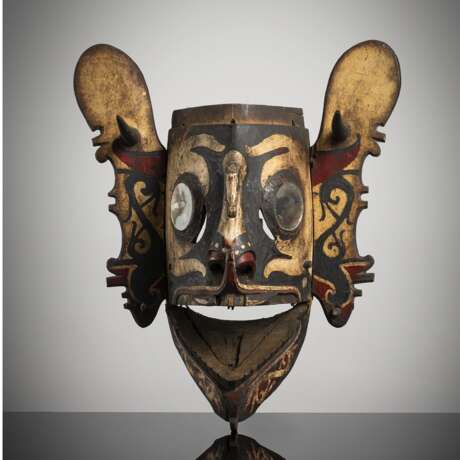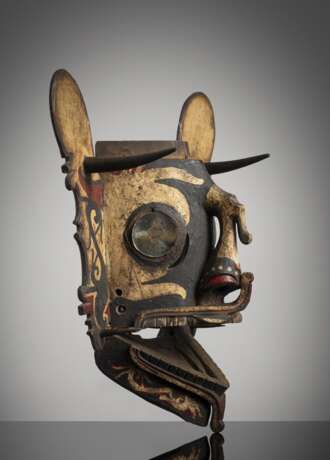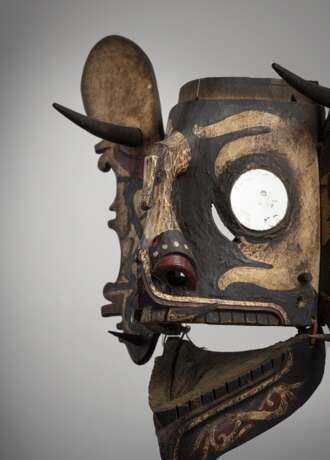ID 1217995
Lot 1478 | Tanzmaske ' hudoq'' aus Holz
Estimate value
€ 900 – 1 500
H. ca, 39 cm
Bei dieser hudoq-Maske, die einen Walddämon als feindlichen Krieger mit Ohrpflöcken darstellt, sind die Augen aus Spiegelglas gefertigt, um die bösen Geister abzuwehren, welche sich beim Anblick ihres eigenen Antlitzes abwenden. Die aus leichtem Holz gefertigte Maske mit Spuren von Benutzung ist rot und schwarz gefasst. Nüstern und Lippen sind rot hervorgehoben, am Kinn erkennt man das ''aso''-Motiv. Das ''aso''-Motiv war vor allem den erfolgreichen Kriegern vorbehalten; es stellt auch bei den berühmten Tatauierungen der Dayak das Hautmotiv dar. Masken dieser Art, hudo oder hudoq genannt, sind typisch für die traditionellen Dayak-Kulturen Borneos. Sie finden Verwendung bei den ''gawaii'' (Erntefesten) der Dayak. Hudoq-Masken werden jedoch auch bei zahlreichen anderen Darbietungen und Festivals und Zeremonien getragen, die Benutzung variiert von Region zu Region. In West-Borneo werden sie auch bei Hochzeitszeremonien und Beschneidungen getragen. Grundsätzlich ist ihr Zweck stets, die unheilvollen Geister zu verjagen. Unter den Kajan und Kenyah (denen diese Maske zuzuordnen ist) werden sie vor allem mit den Reis-Festivals in Verbindung gebracht, in Süd-Borneo, dem Bereich der Ngadju-Dayak, firmieren sie auch bei Bestattungszeremonien. Diese Masken wurden stets von männlichen Tänzern getragen. Als Bekleidung werden hierzu ergänzend Bananenblätter in Streifen geschnitten und zu Umhängen verarbeitet, die die Identität der Tänzer verhüllen. Die Dayak sind die indigene Bevölkerung Borneos. Zu den Dayak werden dutzende verschiedene Volksgruppen gezählt, die sich in Sprache, Kultur und Lebensweise teilweise gravierend voneinander unterscheiden. Der Begriff Dayak stammt vermutlich vom malaiischen Wort daya ab, was "angekommen" bedeutet, in Erinnerung an die einstmalige Einwanderung dieser Gruppen vor der Zeitenwende (die eigentliche Urbevölkerung wird in geringen Zahlen z.B durch die Punan vertreten). Die Siedlungsgebiete der Dayak umfassen die gesamte Insel Borneo und liegen somit im Staatsgebiet der drei Staaten Brunei, Indonesien und Malaysia. Die Dayak gehören zu den austronesischen Völkern, die aus dem südchinesischen Raum kommend, seit Mitte des 3. Jahrtausends v.Chr. Südostasien besiedelten. Die meisten Dayak-Volksgruppen sprechen eigene Sprachen, diese gehören jedoch alle zum malayo-polynesischen Zweig der austronesischen Sprachfamilie.
Aus einer alten deutschen Privatsammlungmn, seit den 1950er Jahren gesammelt - Minim. Altersspuren, partiell wenige kleine Best., Kopfaufsatz fehlt
Lit.: Ave, J. B. / King, V. (1986): People of the Weeping Forest. Tradition and Change in Borneo. Leiden. - Hein, A.R. (1895): Zur Entwicklungsgeschichte des Ornamentes bei den Dayaks. Wien - Sellato, B. (1992): Hornbill and Dragon. Arts and Culture of Borneo. Sun Tree Publishing. - Taylor, P. M. / Aragon, L. V. (1990): Beyond The Java Sea. Arts of Indonesia`s Outer Islands. New York.
| Auction house category: | Ethnographic tribal art |
|---|
| Auction house category: | Ethnographic tribal art |
|---|
| Address of auction |
Nagel Auktionen GmbH Neckarstrasse 189 - 191 70190 Stuttgart Germany | ||||||||||||||
|---|---|---|---|---|---|---|---|---|---|---|---|---|---|---|---|
| Preview | |||||||||||||||
| Phone | +49 (0)711 649 690 | ||||||||||||||
| Fax | +49 (0)711 649 69696 | ||||||||||||||
| Buyer Premium | 29,5% | ||||||||||||||
| Conditions of purchase | Conditions of purchase | ||||||||||||||
| Business hours | Business hours
|





